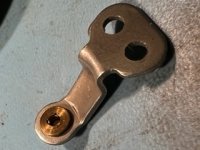ee_chris
Aluminum
- Joined
- Apr 9, 2003
- Location
- Derwood, MD
Hi all,
I have a 1946 square-dial with a non-functional tach. I removed it and think I found why it isn't working, but I'm not sure of the exact problem or what to do about it. The spindle on which the needle mounts has a pin-shaped end to the rear that pivots against something inside a small brass cup on a support arm. The front (needle end) has a shoulder that rides in a plain-bearing collar, and the collar is threaded to permit adjustment in thrust. I can get the back of the spindle to stay on-center in its little cup by finding the spot where the pin "likes" to sit and snugging up the collar, but if I make tight enough for the pin end to stay put, there is too much friction for the hair-spring and aluminum disc to move the needle freely. If it is loose enough for the spindle assembly to turn with a light touch and spring-return, the back end of the spindle quickly falls out of position.
With the support arm removed and looking inside the little cup, I see a tiny white cylinder in the bottom of the cup. I can't really see a divot in the middle, but with a pin probe I can feel where end of the spindle must sit.
- Is the white part a hard substance the spindle is supposed to directly contact?
- Should the white part be a tight fit in the hole, or does light pressure keep it in position? It appears to have a tiny amount of wiggle room.
- There is lots of extra depth in the hole in the brass. Is there supposed to be another part (like a guide bushing of some sort) above the white part in the cup?
- Is the spindle supposed to be sharp on the back end, or rounded? The end is ~0.030" diameter and is fairly flat with a rounded edge.
TIA for any help,
Chris



I have a 1946 square-dial with a non-functional tach. I removed it and think I found why it isn't working, but I'm not sure of the exact problem or what to do about it. The spindle on which the needle mounts has a pin-shaped end to the rear that pivots against something inside a small brass cup on a support arm. The front (needle end) has a shoulder that rides in a plain-bearing collar, and the collar is threaded to permit adjustment in thrust. I can get the back of the spindle to stay on-center in its little cup by finding the spot where the pin "likes" to sit and snugging up the collar, but if I make tight enough for the pin end to stay put, there is too much friction for the hair-spring and aluminum disc to move the needle freely. If it is loose enough for the spindle assembly to turn with a light touch and spring-return, the back end of the spindle quickly falls out of position.
With the support arm removed and looking inside the little cup, I see a tiny white cylinder in the bottom of the cup. I can't really see a divot in the middle, but with a pin probe I can feel where end of the spindle must sit.
- Is the white part a hard substance the spindle is supposed to directly contact?
- Should the white part be a tight fit in the hole, or does light pressure keep it in position? It appears to have a tiny amount of wiggle room.
- There is lots of extra depth in the hole in the brass. Is there supposed to be another part (like a guide bushing of some sort) above the white part in the cup?
- Is the spindle supposed to be sharp on the back end, or rounded? The end is ~0.030" diameter and is fairly flat with a rounded edge.
TIA for any help,
Chris








